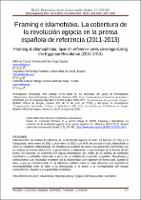Por favor, use este identificador para citar o enlazar este ítem:
https://repositorio.usj.es/handle/123456789/456
| Título : | Framing e islamofobia. La cobertura de la revolución egipcia en la prensa española de referencia (2011-2013) |
| Otros títulos : | Framing & islamophobia. Spanish reference press coverage during the Egyptian Revolution (2011-2013) |
| Autor: | Corral García, Alfonso


Fernández-Romero, Cayetano 
García-Ortega, Carmela 

|
| Palabras clave : | Islamofobia; Framing cultural; Primavera árabe; Islamismo |
| Fecha de publicación: | 31-jul-2020 |
| Editorial : | University of La Laguna |
| Citación : | Corral, A., Fernández Romero, C. y García Ortega, C. (2020). Framing e islamofobia. La cobertura de la revolución egipcia en la prensa española de referencia (2011-2013). Revista Latina de Comunicación Social, (77), 373-392. https://www.doi.org/10.4185/RLCS-2020-1463 |
| Resumen : | Introducción: Se analiza la cobertura de la revolución egipcia en ABC, El Mundo, El País y La Vanguardia, entre enero de 2011 y diciembre de 2013, con el fin de conocer si hubo islamofobia y cómo se manifestó. Metodología: Se estudian las unidades de análisis que presentan islamofobia con un sistema de frames deductivos, o predefinidos, e inductivos, o que emergen de la lectura de los textos. En concreto, se examinan 428 piezas periodísticas por medio de un análisis de contenido cuantitativo y veintidós editoriales a partir de un análisis de contenido cualitativo. Resultados y conclusiones: Los resultados muestran que la islamofobia suele aparecer de forma sutil, cuando lo hace; y que se concentra tanto en el islamismo político como en unos discursos que suscriben la incompatibilidad entre el islam y la democracia, o el atraso y la homogeneidad del mundoaraboislámico respecto a la superioridad occidental. |
| Descripción : | This article evaluates the coverage of the Egyptian Revolution in ABC, El Mundo, El País and La Vanguardia, between January 2011 and December 2013, with the goal to investigate if there was Islamophobia and how it manifested itself. Methods: The study is based on the examination of the units of analysis that present Islamophobia through a system of deductive or predefined frames, and inductive frames, which emerge from reading the texts. Specifically, 428 journalistic pieces are examined through an analysis of quantitative content, and twenty-two editorials based on a qualitative content analysis. Results and conclusions: The results reveal that Islamophobia, when it does appear, does so in a subtle way. Moreover, it concentrates as much on political Islamism as on discourses that subscribe to the incompatibility between Islam and democracy, or the backwardness and homogeneity of the Arab-Islamic world with respect to Western superiority. |
| URI : | https://repositorio.usj.es/handle/123456789/456 |
| ISSN : | 1138-5820 |
| Aparece en las colecciones: | Artículos de revistas |
Ficheros en este ítem:
| Fichero | Descripción | Tamaño | Formato | |
|---|---|---|---|---|
| Framing & islamophobia. Spanish reference press coverage during the Egyptian revolution.pdf | 627,44 kB | Adobe PDF |  Visualizar/Abrir |
Este ítem está sujeto a una licencia Creative Commons Licencia Creative Commons

